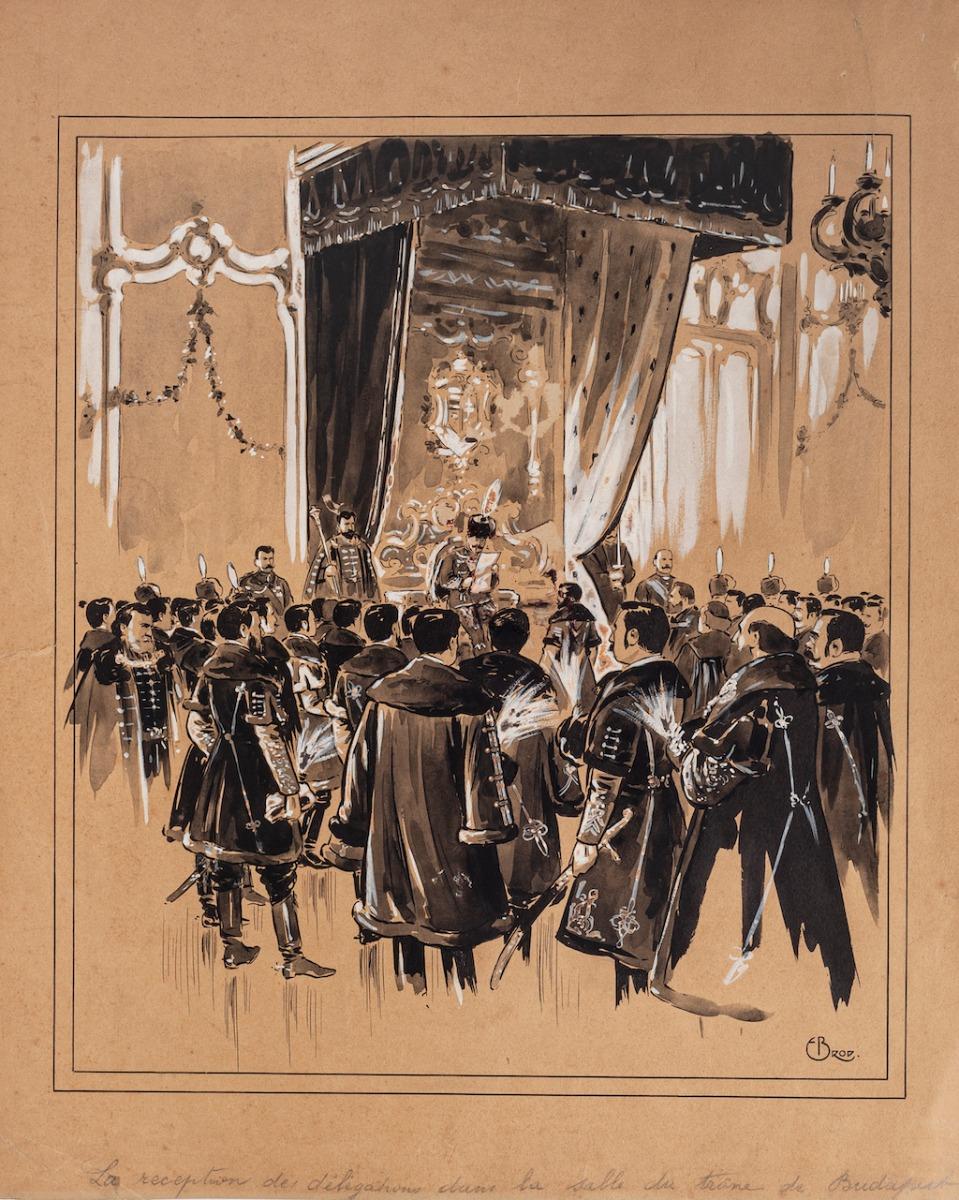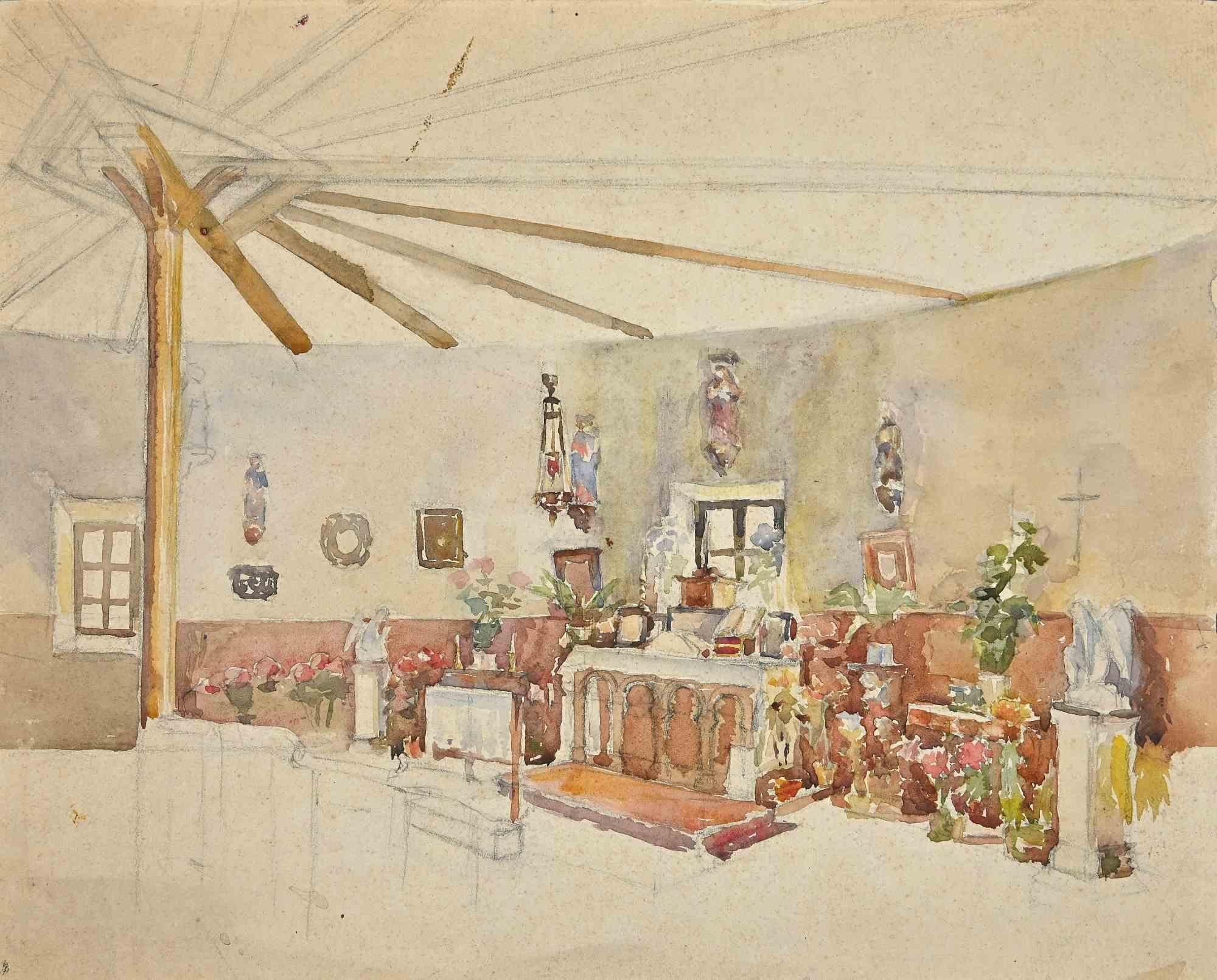Items Similar to 20th century French school, Colonnade in ruins, watercolor
Video Loading
Want more images or videos?
Request additional images or videos from the seller
1 of 16
Unknown20th century French school, Colonnade in ruins, watercolor
About the Item
20th century French school
Colonnade in ruins,
watercolor on paper
37 x 26 cm
Framed in a highly original way between two sheets of Plexiglas (a small, barely visible spot on the blue fabric of the passe partout at the bottom). 52 x 41 cm
This beautiful architectural composition, featuring a classic building in ruins, is part of the great tradition of architectural whimsy and fascination with ruins.
Executed with great mastery and a particularly seductive harmony of colour, it's easy to forget that this is a modern work.
- Dimensions:Height: 14.57 in (37 cm)Width: 10.24 in (26 cm)
- Medium:
- Movement & Style:
- Period:
- Condition:
- Gallery Location:Paris, FR
- Reference Number:
About the Seller
5.0
Gold Seller
These expertly vetted sellers are highly rated and consistently exceed customer expectations.
Established in 2018
1stDibs seller since 2019
210 sales on 1stDibs
Typical response time: <1 hour
- ShippingRetrieving quote...Ships From: Paris, France
- Return PolicyA return for this item may be initiated within 14 days of delivery.
More From This SellerView All
- France 19th century, The Bohème artist in his workshop, watercolorLocated in Paris, FRFrance circa 1850 The Bohème artist in his workshop Watercolor on paper 15.5 x 21.5 cm In good condition except a small tear (visible on the photographs) on the upper right border. I...Category
1840s Romantic Interior Drawings and Watercolors
MaterialsWatercolor
- French school 19th century, Court scene in front of a palace, watercolorLocated in Paris, FRFrench school 19th century, Court scene in front of a palace watercolor on paper 16.4 x 13.3 cm In good condition, some foxings Framed : 30 x 26.5 cm This enigmatic yet charming s...Category
1850s Romantic Interior Drawings and Watercolors
MaterialsWatercolor
- 18th Century Roman School , A Palazzo with antiques, drawingLocated in Paris, FR18th Century Roman School A Palazzo with antiques Brown ink and pen, brown ink wash on paper 12.5 x 20 cm Framed : 28,5 x 35.5 This nice drawing represents a genre scene, with a nobleman, priests, a mother and her children...Category
Early 18th Century Old Masters Interior Drawings and Watercolors
MaterialsInk
- Louis Tinayre (1861-1942) An encampment of journalists, signed drawingLocated in Paris, FRLouis Tinayre (1861-1942) An encampment of journalists in Chambéry, signed and titled lower left "Campement de journalistes à Chambéry" Ink on paper In quite good condition, a a visible vertical fold in the centre, some stains and foxings 21 x 29 cm Framed : 33.7 x 45.5 cm Louis Tinayre's background and adventurous life obviously shed light on this humorous and detailed scene. He shows a remarkable sense of observation, capturing as a journalistic illustrator this scene of extraordianarian life. We don't know for the moment why these journalists had to improvise a camp, probably in a hotel room. No doubt it was to cover a trial or a sensational news item that had filled all the hotels in the city with journalists who had flocked for the occasion. In any case, what interests Tinayre as an almost ethnographic observer is this camp of journalists, of which he makes a tender and comical scene. One understands him better when one knows how he could be fascinated in the same way by the territories of Madagascar, the North Pole or the Far West that he painted and drew. Louis Tinayre was born on 14 March 1861 in Neuilly-sur-Seine. His mother, Victoire Tinayre, was a teacher and a member of the International Workers' Association. Louis was the son of a Communard couple. His father, Jean Joseph, known as Jules Tinayre (Issoire 1821 - Paris 1871) was shot during the Bloody Week. His mother, Victoire Tinayre, fled with her children. Louis was the first to be sent to Hungary, and the rest of the family (including his brother Julien) joined him there later. He studied Fine Arts at the Hungarian University of Fine Arts in Budapest. Returning to Paris in 1880 (after the amnesty), Louis Tinayre assiduously frequented Le Chat noir, where he met the positivists and Adèle Jacomet (Buenos Aires 1867-1946), whom he married in 1888. He became an animal painter and press illustrator and was sent by Le Monde Illustré to cover the second expedition to Madagascar (then under French protectorate) in 1895. He stayed there, fascinated, for six months and produced numerous drawings and photographs. Back in France, he created eight 5 x 4 meters dioramas presented at the National and Colonial Exhibition in Rouen in 1896. He returned to Madagascar in 1898 to prepare the creation of a giant panorama representing the surrender of Antananarivo in 1895. The Malagasy pavilion at the 1900 Universal Exhibition in Paris allowed him to admire the dioramas (on the ground floor) and the panorama (on the first floor). On his second trip, Tinayre took a Lumière cinematograph with him to document the daily life of the Malagasy people, no doubt to facilitate the design of the vast panorama. These short films were donated to the Cinémathèque française in 2009 by his grandson, Alain Tinayre. One of the admirers of Tinayre's drawings, watercolours, paintings and photographs at the Universal Exhibition was Prince Albert I of Monaco: from 1901 onwards, Tinayre accompanied him on his hunts, painting scenes in North Africa, Russia, the Far West (Wyoming) and the North Pole. Tinayre, the official painter of the Prince's scientific expeditions, left his name to a glacier. Together with the painter Alexandre Jean-Baptiste Brun, he painted the four murals in the large amphitheatre of the Oceanographic Institute in Paris. Louis Tinayre painted the figures while Alexandre Brun...Category
1890s Realist Interior Drawings and Watercolors
MaterialsInk
- L V Guirand de Scevola (1871-1950) A Man writing at his desk , Signed pastelBy Lucien-Victor Guirand de ScévolaLocated in Paris, FRLucien-Victor Guirand de Scevola (1871-1950) A Man writing at his desk, 18th century interior scene Pastel on paper Signed upper right 20.5 x 15.8 cm Framed under glass : 37 x 31.5 cm It is known that Guirand de Scevola was very interested in the Palace of Versailles and its Old Regime atmosphere, that he often painted it and that he participated in the Versailles Revival movement at the beginning of the century. This probably led him to paint scenes in the 18th century style, for which he was particularly well known and which are still sought after. What is striking is the modernity of the execution of our pastel, which obviously contrasts with its subject in the style of the 18th century. Guirand de Scevoal is a great colourist and he proves it here with eclat, by building up his composition with white pastel highlights, contrasting with brown and black. There is something of the northern painters in this treatment of light. All this, as always with him, is very subtle. The light radiating from the window is almost an abstract notation, but it gives meaning to this interior scene. Lucien-Victor Guirand de Scévola ( 1871 – 1950) was a French painter. He was student of Fernand Cormon and Pierre Dupuis...Category
1920s Art Deco Interior Drawings and Watercolors
MaterialsPastel
- William Moritz (1816-1860) An historical scene, drawing signedLocated in Paris, FRWilliam Moritz (1816-1860) An historical scene, signed lower left Brown ink and brown ink wash on paper 17 x 16.5 cm Framed : 27 x 23.5 cm The subject of this charming drawing remains unclear but it's really easy to identify Queen Anne of Austria...Category
1850s Old Masters Interior Drawings and Watercolors
MaterialsInk
You May Also Like
- "The Bachelor Girls' Christmas, " Story IllustrationBy Edmund Marion AsheLocated in Fort Washington, PAMedium: Watercolor and Gouache over Graphite Signature: Signed "E.M. Ashe" Lower Left "The Bachelor Girls' Christmas." Illustration for unknown publication. Not dated.Category
20th Century Interior Drawings and Watercolors
MaterialsGouache, Watercolor, Graphite
- "Oh if brother would only let me have the key."Located in Miami, FLSigned "Violet Moore Higgins" in right-center image. Taped to board and matted. Story illustration for unknown publication. Though unconfirmed, it is possible this illustration was produced for The Little Lame Prince by Miss Mulock (Dinah Maria Mulock Craik) (Chicago: Albert Whitman Co., 1927, chapter VII). Violet Moore Higgins, born Violet Idelle Moore, attended the Art Institute of Chicago in the early 1900s, and then settled in New York as an illustrator for children's books and magazines. She has illustrated books like 'Pinocchio', 'Heidi', 'Hans Brinker' and 'The Three Bears'. In the 1910s she made 'Picture Puzzle...Category
1920s Victorian Figurative Drawings and Watercolors
MaterialsWatercolor, Ink
- (Wounded Soldiers)Located in New York, NYWhile this is a World War II drawing, the barbed wire recalls the tranches of the First World War. A menacing tank at the upper left dominates the scene. There is a black border and...Category
Mid-20th Century American Modern Figurative Drawings and Watercolors
MaterialsGouache
- Reception - Ink and Watercolor on Paper by Emile Brod - Early 20th CenturyLocated in Roma, ITReception is an original drawing in ink and watercolor on paper realized by E.Brod. Hand-signed on the lower right. Good conditions except for some stains. The poetic artwork repr...Category
Early 20th Century Figurative Drawings and Watercolors
MaterialsWatercolor, Ink
- The Catch - Original Drawing by Celestin Deshayes - Mid-19th CenturyLocated in Roma, ITThe Catch is an original artwork, gouache, tempera and watercolor realized by Celestin Deshayes (1817 -1896) . Hand signed on the lower right. Is not dated but we can attribute the p...Category
Mid-19th Century Modern Figurative Drawings and Watercolors
MaterialsGouache, Watercolor, Tempera
- Interior of The Church - Original Drawing by Rémy Hetreau - 1930sLocated in Roma, ITInterior of The Church is an original Artwork realized by Remy Hetreau (1913-2001). Realized with pencil, and watercolor on cardboard. in good condition.Category
1930s Modern Interior Drawings and Watercolors
MaterialsWatercolor, Pencil
Recently Viewed
View AllMore Ways To Browse
France School
French School
Interior Classic
20th Century French School
Unknown French School
Architectural Interior Drawings
Painting Ruins
Vintage Whimsies
Architectural Drawings Of Interiors
Unknown Vintage French Watercolor
Passe Partout Vintage
Siyuan Ma
Erte Symphony
T Robert Antique Jewellery
Erte Symphony In Black
Bertha Walker
Robert Camm
T W Camm




